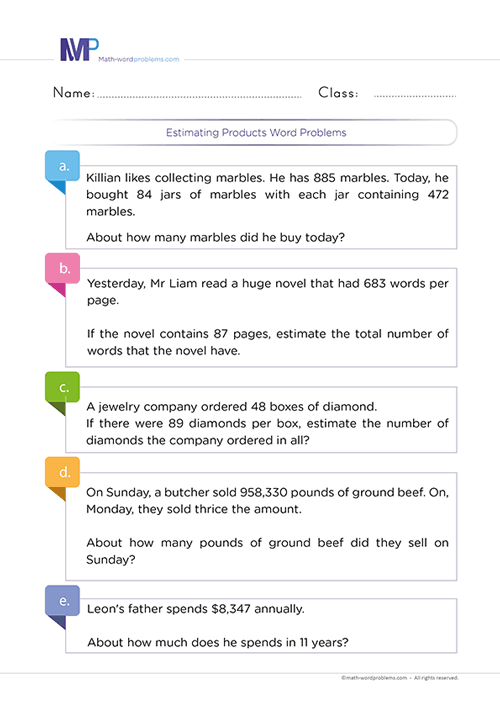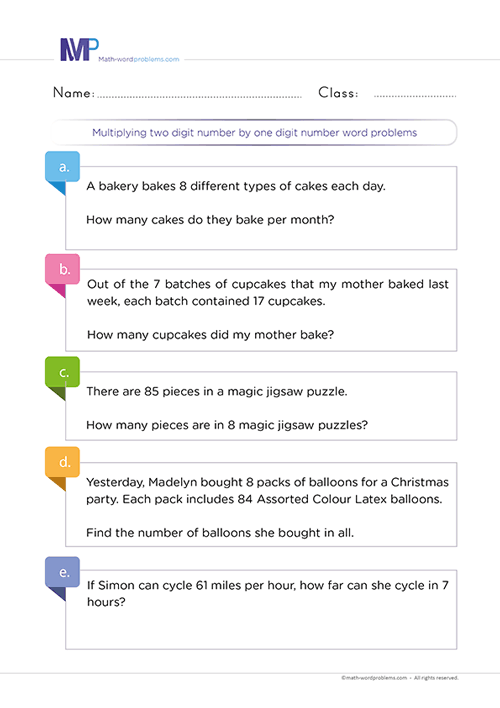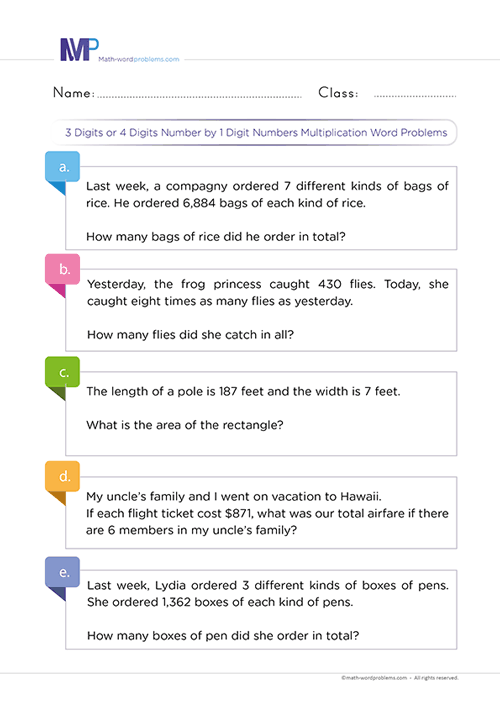 Best strategy to use to estimate products word problems
Best strategy to use to estimate products word problems
This unique and best strategy to use to estimate product word problems will enhance your kids' understanding to solve complex word problems involving the estimation of products effortlessly.
However, we will encourage 4th graders to go beyond the insightful activity of ideal problem-solving and tackle problems on estimating products based on the constraints of authentic reality.
What is the best procedure to use in order to estimate products word problems?
Most often, learners wonder what is the best procedure to use in order to estimate products word problems. Hence, with this enriching step-by-step guide, we will expose fourth graders to realistic mathematical models that will enhance their solving word problems estimation of products skills.
Equally, this resource will offer 4th graders a unique strategy for estimating the product of two factors or more when the rounding place is not mentioned.
Above all, for kids to go through and understand how these steps work, we will solve a few real-life situations, illustrating the best strategy to use to estimate products word problems.
Step 1: IDENTIFY THE PROBLEM
To identify the problem, you have to figure out precisely what the problem wants you to solve by reading and understanding it very well. In other words, the precise mathematical operation you need to do. You can do this by looking for the word problem's most important keywords.
- For instance, if it is estimating whole numbers involving multiplication word problems, you will surely come across one of the following keywords in the word problem: - times, multiplied by, product, the product of, factor, of, multiply, times, multiple, double, triple, groups, by, twice, area, equal groups, every, in all, total, increased by, as much, each, lots of, groups of, per, etc.
- Another important point to note is that there are two ways to determine if a word problem requires you to estimate. First, if you find the words "about … "and "estimate …" in a word problem, then you need to have at the back of your mind that the problem will require estimation at some point.
- In addition to this, you have to take note of the following:
- Know and understand your place values.
- Know when to round up or down.
Note: One key Element for learners to understand is that they should not always rely on keywords alone. That is to say; the same keyword can have different meanings in different word problems.
For this reason, we reiterate on the importance of reading the question very carefully to understand the situation that the word problem is describing, then figure out exactly which operation to use
Step 2: STRATEGIZE OR GATHER RELEVANT INFORMATION
How will you solve or tackle the problem?
Here, what you should have in mind is that; each word problem may need a different format. So, the points below will enable you to solve any format a word problem may present.
- As earlier said, from the keyword(s) in the word problem, you will know if you need to perform multiplication or any other operation.
- However, know that you must not rely merely on keywords. Also, try to understand the situation that the problem is describing.
- After knowing which operation you will perform, construct short expressions/sentences representing the given word problem.
Step 3: CREATE THE EQUATION
Now, write down a numerical equation representing the information given in the word problem.
Step 4: PROVIDE A SOLUTION
From Step 3 above, estimate and add or subtract the numerical equation. Always recall to include the unit of measurement in the final result.
There are a few steps to follow when estimating or rounding.
- Firstly, look at the number to the immediate right of the digit to be rounded.
- If that number is 0-4, keep the digit (to be rounded) the same and replace all numbers to the right of that digit with 0
- But if that number is 5-9, increase the digit (to be rounded) by 1 and replace all numbers to the right of that digit with 0.
Step 5: CHECK YOUR WORK
Lastly, ask yourself this question. "Does my answer make sense?" If "YES," you are done. If "NO," go back to step 1 and start again.
Examples on estimating products word problems
Example one
Step 1:The important numbers here are 15 and 12. The keyword(s) found in the word problem is "each" and total.
Step 2:How will you solve the problem? The situation that the problem is describing and the keywords found in the word problem imply a multiplication operation. Also, the phrase "about" tells you, you have to estimate at some point.
Now, create short sentences to represent the given word problem.
- Number of packets that had 12 pencils each = 15 packets
- Number of pencils in each packet = 12
- The number of pencils in 15 packets = the number of packets with 12 pencils each × the number of pencils in each packet.
- Therefore, the estimated number of pencils in 15 packets = the estimated number of packets with 12 pencils each × the estimated number of pencils in each packet.
Step 3: Now, write down a numerical equation to represent the first bolded sentence in step 2 above to solve this word problem:
15 × 12 = ?
Step 4:From Step 3 above, estimate and divide the whole numbers by following the steps below.
- Firstly, look at the number to the immediate right of the digit to be rounded.
- Then, if that number is 0−4, keep the digit to be rounded the same and replace all numbers to the right of that digit with 0
- But if that number is 5−9, increase the digit to be rounded by 1 and replace all numbers to the right of that digit with 0.
- Remember to add the unit of measurement to your final answer, if any.
15 × 12 ≈ 20 × 10 = 200
Since there are 200 pencils in the 15 packets of pencils I bought, my estimation of 200 pencils sounds about right.
Step 5: Finally, check your work – Ask yourself this question. "Does my answer make sense?" If "YES," you are done. If "NO," go back to step 1 and start all over again.
Example Two
Step 1: The important numbers here are 452 and 85. The keyword(s) found in the word problem is "how many."
Step 2: How will you solve the problem? From the situation the problem is describing and the keyword(s) found in the word problem, you need to perform a multiplication operation. The phrase "about" shows that we have to estimate.
Now, create short sentences to represent the given word problem.
- Number of jars of marbles that he bought today = 85
- Number of marbles in each jar = 452
- The number of marbles in all the 85 jars = the number of jars of marbles that he bought today × the number of marbles in each jar
- Therefore, the estimated number of marbles in all the 85 jars = the estimated number of jars of marbles that he bought today × the estimated number of marbles in each jar
Step 3:Now, write down a numerical equation to represent the first bolded statement in step 2 above to be able to solve this word problem:
452 × 85 = ?
Step 4: From Step 3 above, estimate and multiply the whole numbers following the steps below.
- Firstly, look at the number to the immediate right of the digit to be rounded.
- Then, if that number is 0-4, keep the digit (to be rounded) the same and replace all numbers to the right of that digit with 0
- But if that number is 5-9, increase the digit (to be rounded) by 1 and replace all numbers to the right of that digit with 0.
- Another key thing to remember is the unit of measurement in the final result.
Before you continue, notice that from step 3 above in the equation, one of the factors has just two digits.
So, the question you'll ask yourself is, "what am I supposed to do in this case, since I wasn't told the place value each factor in the equation will be rounded to?"
In such situations, round the factor with two digits to the nearest tens and the factor with three digits to the nearest tens too.
452 × 85 ≈ 450 × 90 = 40,500
So, he bought about 40,500 marbles today
Step 5: Finally, check your work – Ask yourself this question. "Does my answer make sense?" If "YES," you are done. If "NO," go back to step 1 and start all over again.






